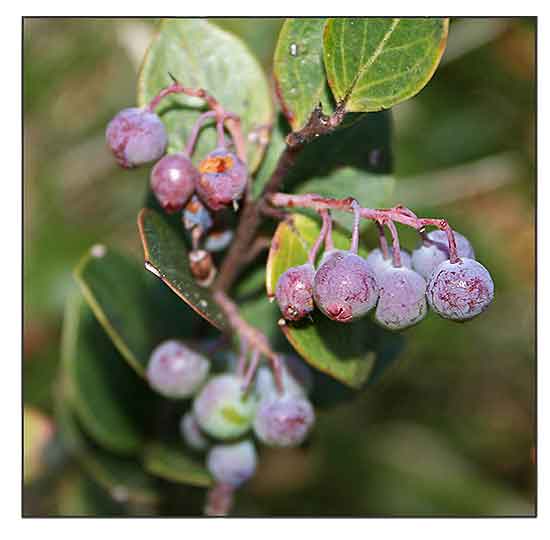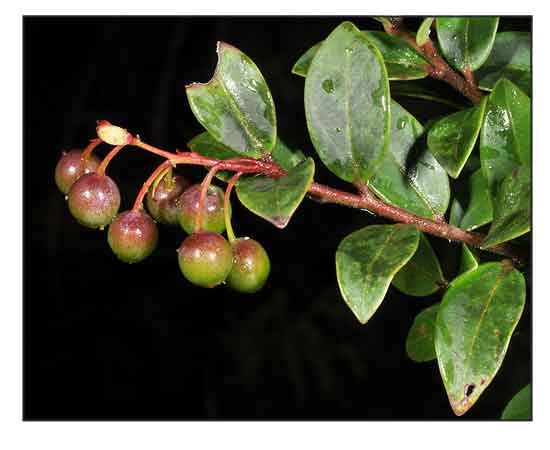Gen info
- Vaccinium is a common and widespread genus of shrubs or dwarf shrubs in the heath family Ericaceae.
- The genus was first described by Carl Linnaeus in 1753.
- Vaccinium may be derived from Latin bacca, but the ultimate derivation is obscure. (2)
- Taxonomy is complex and still under investigation. A number of Asian species are more closely related to Agapetes than to other Vaccinium species. (2)
 Botany Botany
Vaccinium myrtoides is a shrub or small tree with a height range of 0.3-2 m. Branchlets are slender, erect, shortly patently pubescent. Leaves are more or less densely to subimbricately arranged, ovate to oblong-ovate or broad elliptic, apex gradually attenuate or sub-acuminate, obtuse, base rounded or slightly cordate, with 1-2 minute, impressed, marginal glands in the lower third on each side, (sub)coriaceous, fugaciously puberulous when very young, glabrous at maturity, though remaining are more or less puberulous and ciliate at the very base, the petiole and the very apex, sparsely glandular-punctate beneath, 1.3-2 by 0.7-1.3 cm, entire, edge marginate, midrib slightly sunken at least in the lower part above, prominent beneath, nerves 4-5 pairs, spreading, anastomosing, raised beneath only, reticulation subdense and mostly well recognizable beneath. Petiole is 1-1.5 by c. 0.8 mm. Racemes from the upper axils, laxly 6-8 flowered. Rachis is angular, finely puberulous or mostly glabrous 1.5=4 cm/ Pedicels nodding at anthesis, puberulous or mostly glabrous, 0.5-1 cm. Bract foliacious, small but partly persistent, up to 0.8 cm. Calyx is a cup-shaped tube, base more or less truncate, glabrous, c 1.5 mm long and wide, lobes triangular, more or less acute. Corolla shortly cyliindric-urceolate, red, pink or white to cream, glabrous at both sides, 4 by c. 2.5 mm, lobes obtuse, recurved, c 0.8 mm. Filaments linear, dilated below, curved, villous especially below, 1.5mm; anther cells broad-oblong, echinulate-papillose, 1-1.3 mm including the tubules, the latter as wide and almost half as long as the cells, obliquely cut at apex. Disk densely hairy. Style glabrous, c. 3 mm. Fruit globose, glabrous, finally bluish blackish, 4-5 mm. (3)
 Distribution Distribution
- Native to the Philippines. (1)
- Found in mountainous areas in the Philippines: Ilocos Sur, Mountain Province (Sagada, Mt. Data, Bauko), Ifugao,, Benguet, Laguna-Quezon (Mt. Cristobal, Mt. Banahaw)
, Mindoro, Mindanao.
- Commonly found on steep, rocky, open and bare slopes, open grasslands, sandy or volcanic soil.
- Locally abundant in Benguet, at elevations from 1000-3000 m.
(3)
- Also native to Maluku and Sumatera.
Constituents
- In a comparative study of total phenolic and flavonoid contents, Ayosep showed the highest polyphenol (59.12 mg gallic acid equivalent per 100g fresh weight) and flavonoid (1186.44 mg quercetin equivalent per 100 g fresh weight). Results suggest the fruits can be recommended as sources of natural antioxidant. (see study below) (4)
Properties
- Studies have suggested antibacterial, antioxidant, radical scavenging, immunomodulatory, hepatoprotective properties.
Parts used
Fruit, stems, leaves.
Uses
Edibility
- Fruit is edible, eaten raw.
- Fruit used for making jelly, juice and wine.
- Leaves used for making tea.
Folkloric
- In the Philippines, the Kalanguya tribe of Tinoc, Ifugao use the plant stem decoction as a traditional wash for fever (Galvez 2015). (3)
- In Benguet, fruit is considered beneficial for poor eyesight, diabetes, flu, and as antioxidant and anticancer medication (Barcelo 2014) (3).
Others
- Ritual: The highest rank among ten fruits used as offering to the deity. (3)
- Ink: Fruit source of ink or dye.
- Tecap Liquid: A patent application was filed for use of the fruit as a component of Tecap Liquid, a natural drink formula for balancing of vaginal pH, reducing vaginal odor, and/or reducing body odor (Allen 2018). (3)
Studies
• Comparative Polyphenol and Flavonoid Content: In a comparative study of total phenolic and flavonoid contents of fruits of Vaccinium myrtoides (Ayosep), Annona muricata (Guyabano), Garcinia mangostana (Mangosteen) and Fragaria x ananassa (Strawberry), Ayosep showed the highest polyphenol (59.12 mg gallic acid equivalent per 100g fresh weight) and flavonoid (1186.44 mg quercetin equivalent per 100 g fresh weight). Results suggest the fruits can be recommended as sources of natural antioxiidants. (4)
• Immunomodulatory / Antioxidant / Fruit: Study evaluated the phenolic flavonoid content, antioxidant and immunomodulatory properties of V. myrtoides. In vitro immune-based assays showed significant activity of BBE on murine lymphocyte proliferation at 5µg/ml BBE (p<0.05) and ROS scavenging at 50 µg/ml BBE (p<0.05)./ Results suggest V. myrtoides can possibly effect immunomodulation through lymphocyte proliferation and ROS scavenging. (5)
• DPPH Radical Scavenging Activity: In a study of ethanolic leaf extracts of 10 medicinal plants for antioxidant and DPPH radical scavenging activity, Vaccinium myrtoides showed the strongest antioxidant activity. V. myrtoides showed the highest DPPH radical scavenging activity with IC50 20.85 µg/ml, which was higher than ascorbic acid 21.56 µg/ml. Phytochemical screening yielded phytosterols, flavonoids, phenolic compounds, and tannins, with absence of alkaloids, glycosides, saponins, and terpenoids. (6)
• Antibacterial / Leaves: In a study of ethanolic leaf extracts of ten folkloric medicinal plants for antibacterial activity, Vaccinium myrtoides exhibited partial activity against Pseudomonas aeruginosa with a mean zone of inhibition of 12 mm. (7)
• Hepatoprotective / Fruit: Study evaluated the hepatoprotective effect of Philippine native blueberry (Vaccinium myrtoides) crude ethanolic fruit extract against cyclophosphamide-induced liver toxicity in mice. Histopathological scoring showed visible reduction of necrosis and steatosis with fruit extract administration. Results suggest potential for ameliorating the hepatotoxic effects of cyclophosphamide. (8)
Availability
Wild-crafted. |

![]()





